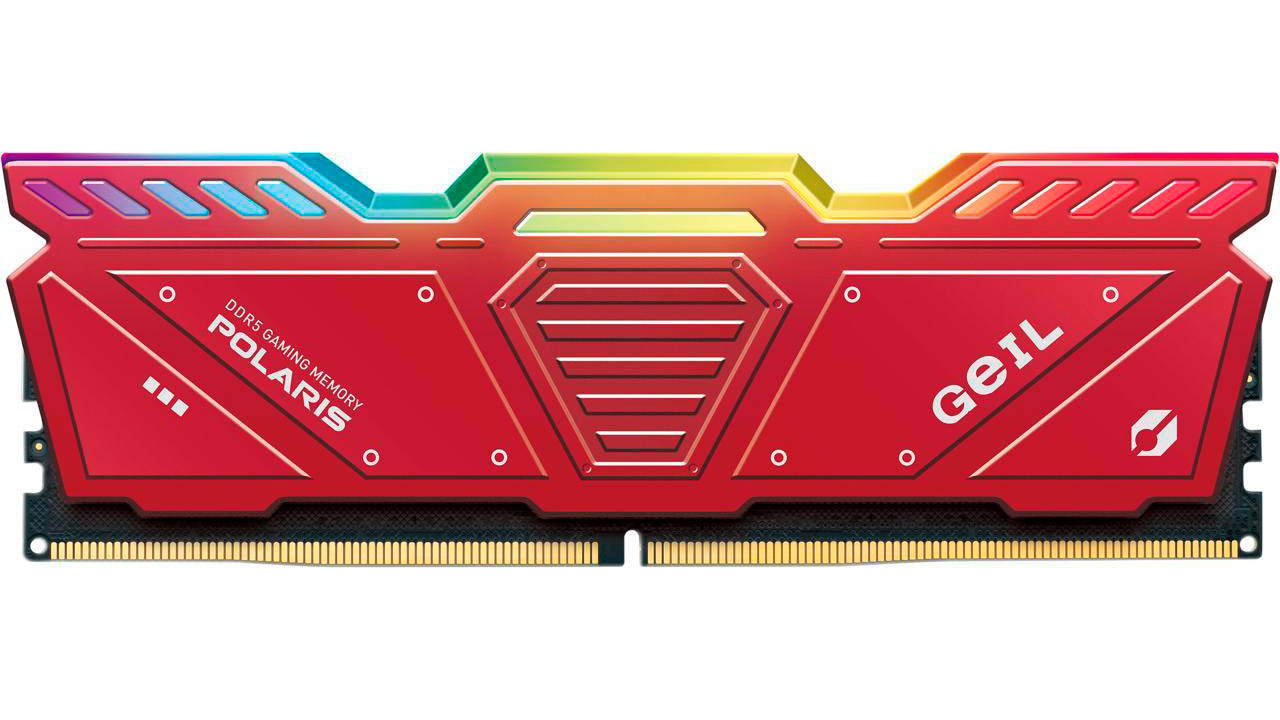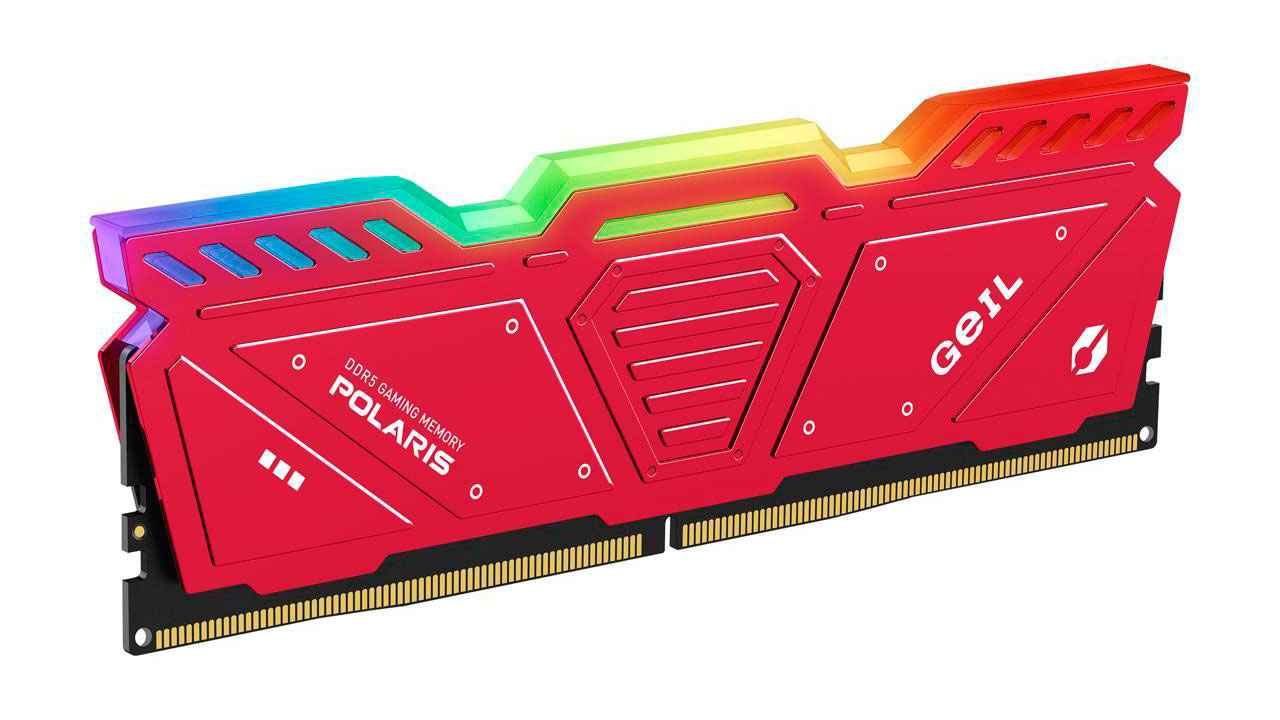If you missed out on the previous DDR5 sale, now's your chance to take a second crack at it. Newegg (via momomo_us) has put up GeIL's Polaris RGB Sync DDR5-4800 32GB (2x16GB) for purchase for $349.99.
The Polaris RGB Sync DDR5-4800 (GOSR532GB4800C40DC) is a dual-channel memory kit that's comprised of two 16GB DDR5 non-ECC memory modules. The memory runs at DDR5-4800 by default with 40-40-40-77 timings and a 1.1V DRAM voltage so no overclocking is necessary. This means that the memory kit should be plug-n-play with Intel's forthcoming 12th Generation Alder Lake processors, which come with native DDR5-4800 (PC5-38400) support.
According to an Intel document for DDR5-4800 validation on Alder Lake, we can expect early DDR5 products to leverage 16-gigabit chips from either SK hynix, Samsung or Micron. Irrespective of the DRAM vendor, the Polaris RGB Sync 16GB memory modules are likely utilizing a single-rank (1Rx8) design.


Unlike TeamGroup's DDR5-4800 32GB memory kit that retailed for $310.99, the Polaris RGB Sync carries a $39 premium. Then again, GeIL's memory kit does come with a fancy heat spreader and flashy RGB lighting. The company offers the Polaris RGB Sync in three colors: white, grey and red. In additon to the 32GB (2x16GB) presentation, the Polaris RGB Sync is also available as single DIMMs and 16GB (2x8GB) and 64GB (2x32GB) kits.
It makes very little sense to pick up a DDR5 memory kit right now since Intel's Alder Lake chips and matching Z690 motherboards aren't officially purchasable yet. More importantly, it remains to be seen whether DDR5 will usher in a significant performance uplift over DDR4. Obviously, we don't expect the initial DDR5 offerings to contend with the best RAM on the market.
Get Tom's Hardware's best news and in-depth reviews, straight to your inbox.

Zhiye Liu is a news editor, memory reviewer, and SSD tester at Tom’s Hardware. Although he loves everything that’s hardware, he has a soft spot for CPUs, GPUs, and RAM.
-
hasten Hideous looking heatsink. I was hoping the industry was moving away from the stylings from 90s cinema.Reply -
aetolouee Replywith 40-40-40-77 timings
Holy latency can't wait to see its impact on frame times when gaming. Hopefully it will be nothing but damn. I guess its the price we have to pay for ECC -
InvalidError Reply
Except these aren't ECC DIMMs, at least not on the bus-facing side of things. Most of the increased latency comes from the lowered voltage and the command buffering chip.aetolouee said:Holy latency can't wait to see its impact on frame times when gaming. Hopefully it will be nothing but damn. I guess its the price we have to pay for ECC
The first year of DDR4 also had much worse latency than budget-friendly mature DDR3 available at the time. Also, if you want to run today's crazier high-speed low-latency memory, you have to run those DIMMs at 1.35+V when DDR4 is nominally only 1.2V..
As far as games go, it'll probably be a wash - win some from higher bandwidth, lose some to worse latency. The win-lose spread should be interesting. -
Moscato Replyaetolouee said:Holy latency can't wait to see its impact on frame times when gaming. Hopefully it will be nothing but damn. I guess its the price we have to pay for ECC
That latency is actually a jedec specification
That's like using cas 20 ddr4 2400 conceptually -
cryoburner ReplyThe memory runs at DDR5-4800 by default with 40-40-40-77 timings and a 1.1V DRAM voltage so no overclocking is necessary.
$350 for 32GB of slow, bottom-of-the barrel DDR5? It's probably expected, given the typical pricing trends for new RAM generations, though I imagine a number of people will be tricked by the RGB lighting and higher frequency (compared to DDR4) into thinking this is a premium RAM kit. In reality, DDR5 starts at 4800 speed, so this is roughly comparable to the place 2133 serves in the market for DDR4.
That wouldn't be bad if the latency was in-line with existing RAM kits, but typical mainstream (OC) kits of DDR4 tend to have absolute latency of around 10-11ns, while this kit's latency works out to 16.6ns. That's slower latency than even budget DDR4-2400 and 2133 kits have. The frequency is obviously higher, but that can only help so much with latency that high. I wouldn't be surprised if a $120 32GB kit of DDR4-3600 CAS 18 manages to outperform kits like this in games and many other workloads.
People should probably look into comparisons of how different types of RAM affect the performance of Alder Lake prior to building a system around it. Both DDR4 and DDR5 high-end motherboards will apparently be available, but I suspect you will have to pay a lot more than $350 for a DDR5 kit that manages to perform better than DDR4 kits available for a fraction of the price. -
InvalidError Reply
Maybe, maybe not. DDR4 may have lower first-word latency but CPU caches usually work with cache lines. DDR5-4800 may take 6.7ns fetching the first word from a row but it completes 16-words bursts 2ns faster, which makes DDR5 only 4ns slower for single bursts.cryoburner said:The frequency is obviously higher, but that can only help so much with latency that high. I wouldn't be surprised if a $120 32GB kit of DDR4-3600 CAS 18 manages to outperform kits like this in games and many other workloads.
Not so bad when you also account for the fact that read/writes are usually interleaved across different banks to hide most of the latency and increase data bus utilization.
Decently optimized games usually organize their data in chunks for efficient sequential processing and shouldn't get hurt too badly by the increased latency. Tasks with a higher random read/write pattern like code compiling might get a significant handicap. -
cryoburner Reply
Perhaps, though seeing as even a lot of Z690 boards will be DDR4 models suggests that DDR4 may still be the norm for most high-end PCs this generation, and I'm not sure that would be the case if DDR4 left much performance on the table. Even if it were to perform similar or slightly better, it really doesn't seem like a "low-end" DDR5 kit like this is going to be worth the massive premium over DDR4, at the very least. Of course, that goes for existing high-performance DDR4 kits as well, as the performance differences for paying two or more times as much for high-end RAM tend to be imperceptible in real-world workloads.InvalidError said:Maybe, maybe not. DDR4 may have lower first-word latency but CPU caches usually work with cache lines. DDR5-4800 may take 6.7ns fetching the first word from a row but it completes 16-words bursts 2ns faster, which makes DDR5 only 4ns slower for single bursts.